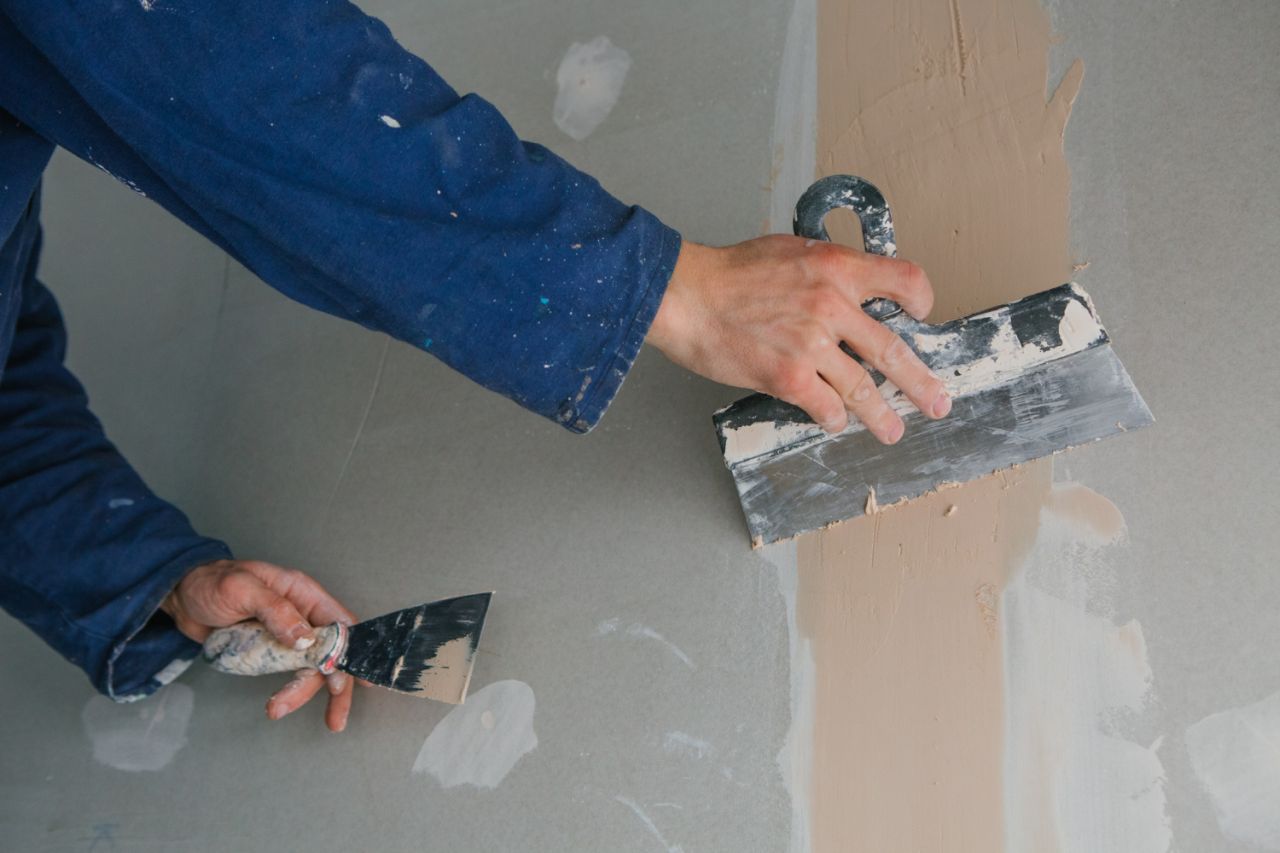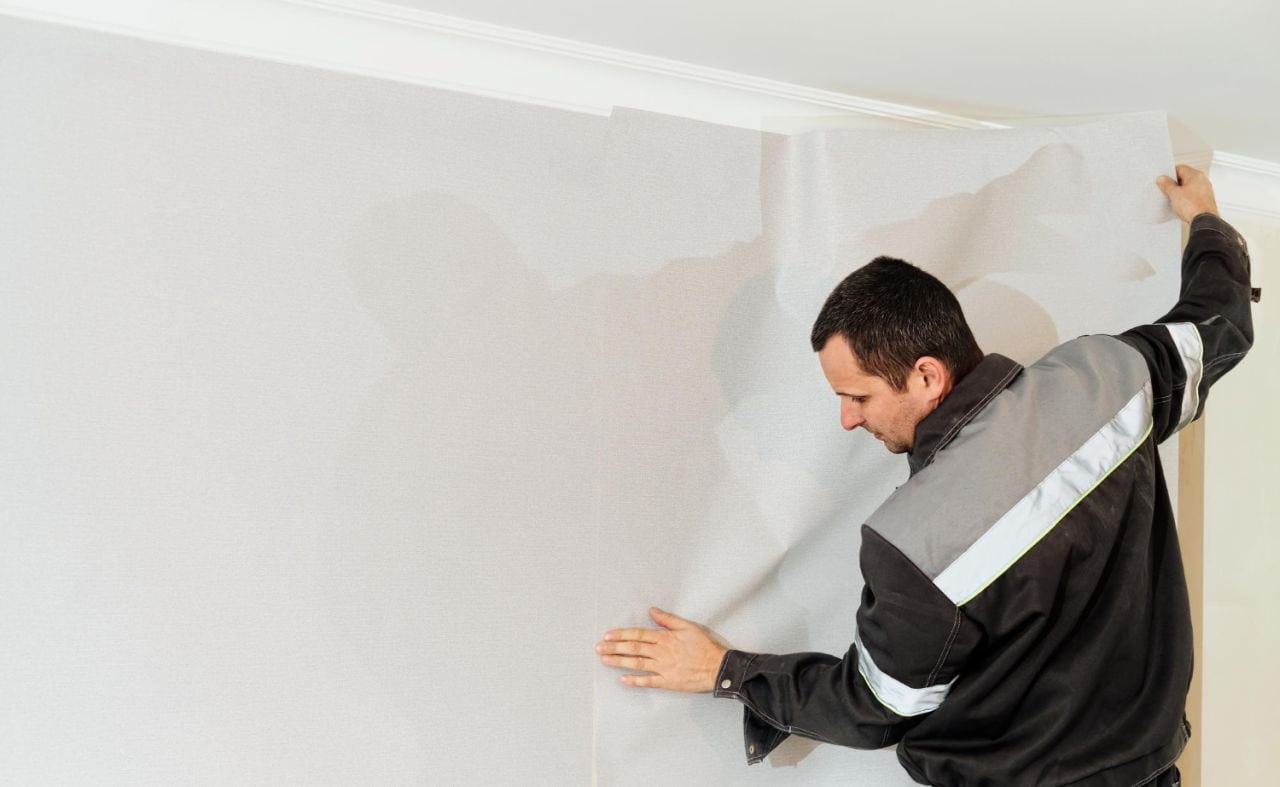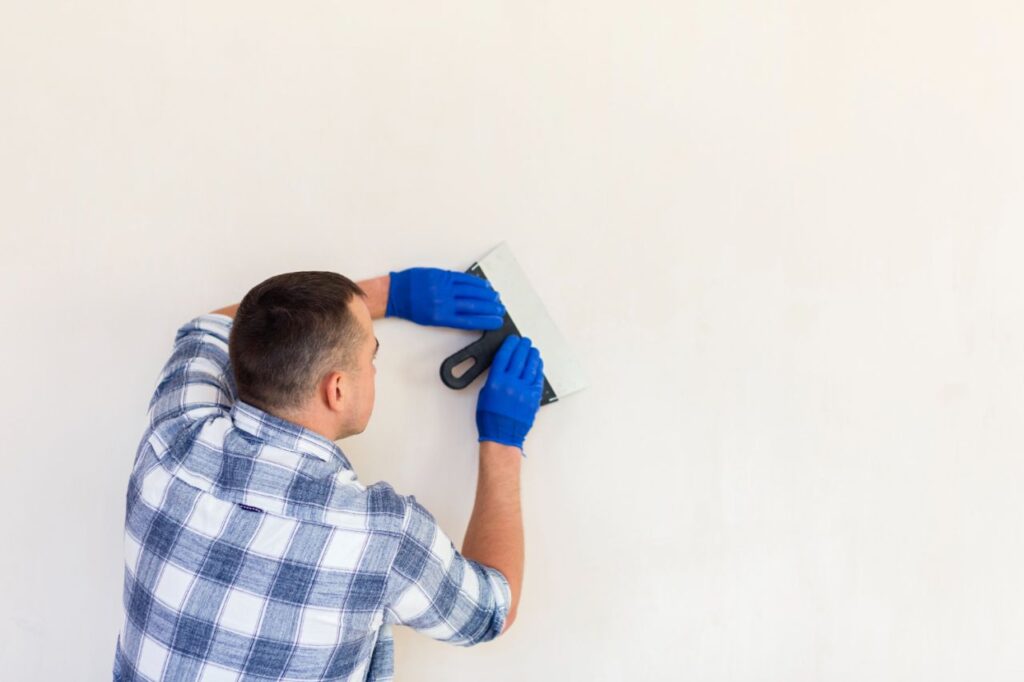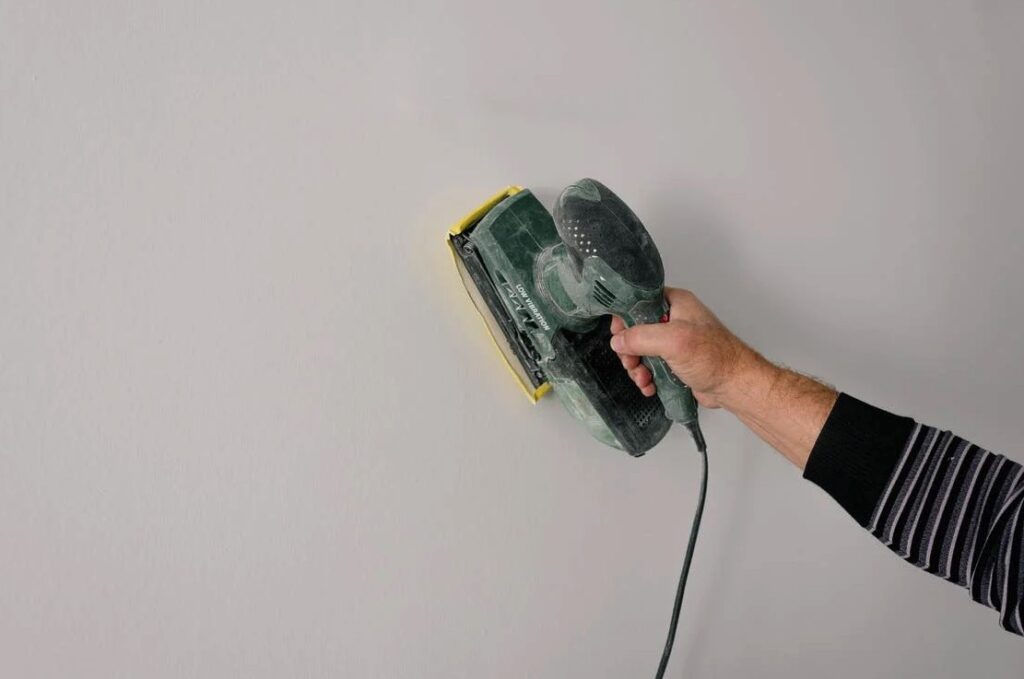Those with the means to do so have been using Venetian polished plasters to produce exquisite finishes on their walls since the Middle Ages.
Depending on the desired look, fine grain finishes like marble polished plaster can have a thickness anywhere from 0.5 to 1 mm, and the product is made to be plastered in super thin layers that are built up in phases.
Marble plasters, polished plasters, fine grain marmorino, polished stucco, and polished gypsum are all common names for these materials.
The high gloss, traditional methods of hand application with a spatulato, and glossy finish generated by these materials have made them popular.
The primary ingredients of traditional Venetian plasters are fine marble dust, slaked lime putty, natural waxes, and oils. Unique and high-quality finishes can only be achieved through a Venetian plaster application that skilfully blends historic artisan techniques with modern aesthetic preferences.
Types of Stucco
Stucco is a common external coating that might include any cement, sand, and lime. It has a long history of usage in the building industry as an attractive and long-lasting finish for walls, ceilings, and other surfaces. Different types of stucco require different methods of application to achieve the desired effect. The most popular varieties of stucco are described here.
Traditional Stucco
Traditional stucco is created using Portland cement, sand, and water. It is also known as cement stucco or Portland cement stucco. The multiple coats of this finish make it extremely tough and long-lasting.
Scratch coat is the first layer, then brown coat, and finally the finish coat, which is typically a coloured paint. Its popularity stems from the fact that traditional stucco may be applied to a wide variety of substrates, including concrete, brick, and stone.
Synthetic Stucco
Synthetic stucco is a multi-coat system that consists of an insulation board, a base coat, a reinforcing mesh, and a finish coat; this is sometimes referred to as an External Insulation and Finish System (EIFS).
Synthetic stucco is a type of exterior wall covering typically installed over an insulating foam board. It is an ideal building material for the twenty-first century since it is lightweight, energy-efficient, and resistant to dampness.
Venetian Stucco
Venetian stucco is a form of stucco with a highly polished finish that mimics the look of marble. It is also known as polished plaster or marble plaster.
Smooth and lustrous surfaces can be achieved by applying multiple thin coatings of this mixture of slaked lime, marble dust, and colours.
Because of its high quality and long lifespan, Venetian stucco is often used in expensive residential and commercial construction.
Acrylic Stucco
Synthetic stucco like acrylic stucco is fabricated using acrylic polymers, sand, and other ingredients. It looks like traditional stucco but is more durable and flexible, and won't crack or fade over time. Acrylic stucco can be applied to many different materials, including concrete, wood, and metal, and comes in a broad variety of colours and textures.
Lime Stucco
The basic ingredients of lime stucco are lime, sand, and water.
It's been used for building for ages and has a long history of tradition. Because of its breathability, flexibility, and longevity, lime stucco is often used for restoring older buildings.
Lime stucco comes in a variety of textures and hues because it can be mixed with different types of sand.
Stucco may be altered to fit a wide variety of aesthetic requirements, making it a highly adaptable building material. Some of the most prevalent kinds of stucco are traditional stucco, synthetic stucco, Venetian stucco, acrylic stucco, and lime stucco. According to the specifications and budget of your project, you should select the best type of stucco from among the many available.
Advantages of Venetian Plaster
A decorative finish used for centuries in Italy and elsewhere, Venetian plaster is also known as polished plaster or marble plaster.
Smooth, lustrous, and resembling marble, it is formed of slaked lime, marble dust, and colours and put in thin layers.
Due to its high-end appearance and feel, Venetian plaster has seen a surge in popularity in recent years. Here are some of its advantages:
Durability

Plaster from Venice is noted for its longevity and resilience. It's a high-performance substance that holds up well in the face of water, blunt force, and wear and tear. Hallways, living rooms, and businesses are just some of the places where Venetian plaster might shine.
Aesthetics
Plaster from Venice has a distinct style that is difficult to imitate. It's deep and luxurious, perfect for adding a touch of class to any room. Venetian plaster can be painted or textured to meet the needs of any interior design scheme.
Versatility
Walls, ceilings, columns, and other architectural components can all benefit from being covered in Venetian plaster. It's also versatile, as it can be used indoors or out. Whether you're going for a modern or classic aesthetic, Venetian plaster can be altered to suit your needs.
Breathability
Since it is porous and allows water to evaporate, Venetian plaster can be used to keep a room at a comfortable humidity level. This is especially helpful in humid climates or in older buildings.
Easy Maintenance
Cleaning Venetian plaster only requires a moist cloth or a light detergent, making it low-maintenance. There's no need for any kind of specialised equipment or toxic chemicals to clean it. In addition, a touch-up kit makes quick work of repairing minor damage like scratches or nicks.
Sustainable
The materials used to create Venetian plaster are all-natural and sustainable, such as lime and marble dust. It is free of VOCs, or volatile organic compounds, which can be hazardous to human and environmental health.
Venetian plaster is also a durable material that can extend the time between repairs.
Venetian plaster is an adaptable and long-lasting substance with many applications in design and construction.
Its distinctive appearance, adaptability, breathability, low maintenance requirements, and long lifespan all contribute to its widespread appeal among designers, builders, and homeowners.
Venetian plaster may be the best option if you want to increase the value and aesthetic appeal of your home through the use of high-performance material.
Disadvantages of Venetian Plaster
Although Venetian plaster offers numerous benefits, there are a few drawbacks to think about before deciding to use it as a finishing material. Some of the issues with using Venetian plaster are highlighted here.
Cost
The cost of a Venetian plaster finish may exceed that of a standard plaster or paint job. The added expense may result from the need for expert labour and additional coats. Plastering a room in Venetian style can cost anything from a few hundred to several thousand dollars, depending on factors including square footage, design complexity, and plaster quality.
Time-consuming installation
It takes a lot of time and multiple applications of Venetian plaster to get a good finish.
Plaster is applied in very thin layers, let to cure, and then the surface is polished. It may take many days or even weeks to finish the installation, depending on the size of the room.
Imperfections
Since Venetian plaster is a hand-applied coating, it may have slight flaws. Minor texture or colour irregularities, as well as clearly visible seams between pieces of plaster, are examples of such flaws. While faults in Venetian plaster add to the material's unique character, they may not work with every design scheme.
Not suitable for all surfaces
Not every surface can take the rigours of Venetian plaster.
For effective adhesion, a flat, smooth surface is required. Plaster is more likely to crack or chip over time if it doesn't cling well to an uneven or cracked surface. Also, locations with high moisture or humidity levels, such as bathrooms or kitchens, may not be appropriate for Venetian plaster.
Difficult to repair
Little damage to Venetian plaster can be fixed using a touch-up kit, but more extensive damage might be tricky to fix. It may be necessary to remove and repair the damaged plaster, which can be a time-consuming and expensive process.
Limited colour options
The colour palette for Venetian plaster is extensive, but it may be more limited than that of other paints and plasters. Natural pigments are often used to make Venetian plaster, which can limit the range of colours available.
It's also possible that certain hues will be more difficult to attain than others, which will increase both the price and the time required for installation.
There are many positive aspects to using Venetian plaster as a wall covering, but there are also some potential drawbacks to think about.
It's important to weigh the benefits against the price, installation time, defects, incompatibility with particular surfaces and humidity, and restricted colour palette.
The benefits of Venetian plaster in terms of aesthetics and longevity, however, may make up for the drawbacks.
Why Venetian Plaster is Popular?
Italians have been using Venetian plaster, also called polished plaster, for centuries, but it has only recently acquired appeal outside of Italy. Slaked lime, marble dust, and colours are what make up the high-end finish known as Venetian plaster.
It's used in very thin coats to make surfaces that look like polished marble. Although expensive, Venetian plaster is gaining in popularity for a number of reasons.
The lavish appearance and feel of Venetian plaster are difficult to achieve with any other type of surface treatment. Its depth and richness lend any room an air of opulence and refinement. Light is reflected in a novel way by the smooth, glossy surface of Venetian plaster, giving the illusion of depth and perspective.
Venetian plaster can be painted or textured to meet the needs of any interior design scheme. This paves the way for designers and homeowners to make environments that are truly one-of-a-kind and reflective of their personal tastes. Because of its adaptability, Venetian plaster can be utilised to achieve a wide variety of aesthetic effects, from the ultra-modern to the classically elegant.
The plaster used in Venetian construction is extremely sturdy and long-lasting. In addition to being resistant to water and impacts, this high-performance material is also resistant to wear and tear.
High-traffic areas, such as hallways, living rooms, and businesses, benefit greatly from the use of Venetian plaster.
Natural materials like lime and marble dust are used to create Venetian plaster, making it a sustainable building material. No potentially dangerous volatile organic compounds (VOCs) were found in its production.
Because of its durability, Venetian plaster also helps homeowners avoid constant repairs and replacements.
The classic appeal of Venetian plaster has made it popular for ages, and it may increase the worth of any room it's used to decorate. Its timeless elegance has made it a fan favourite for ages and will likely continue to do so for the foreseeable future. Venetian plaster is a classic alternative that can increase a home's value, unlike fashionable finishes like wallpaper or bright paint colours.
Since it is porous and allows water to evaporate, Venetian plaster can be used to keep a room at a comfortable humidity level. This is especially helpful in humid climates or in older buildings. Venetian plaster also helps to improve interior air quality since it does not collect dust and other irritants.
Venetian plaster's widespread acceptance stems from a number of factors, including its high-end aesthetic, practicality, longevity, sustainability, classic style, and capacity to enhance indoor air quality.
Venetian plaster's high upfront expense is justified by the aesthetic and functional benefits it provides to a building. It's also worth noting that the price of Venetian plaster may change based on the square footage being plastered, the intricacy of the pattern, and the specific type of plaster being used. The price of Venetian plaster can sometimes be on par with that of other luxury materials like marble and granite.
The demand for individuals with expertise in applying Venetian plaster has also increased in recent years.
This has made it simpler to track down skilled professionals capable of installing Venetian plaster to exacting standards, which bodes well for the final product.
Finally, the desire for one-of-a-kind homes may have contributed to Venetian plaster's rise in popularity. Rather than settling with mass-produced, cookie-cutter solutions, many homeowners and designers are on the hunt for personalised finishes. Venice plaster allows for a great deal of quality finishes.
Conclusion

The use of polished Venetian plasters to create beautiful wall finishes dates back to the Middle Ages. Natural waxes and oils are combined with fine marble dust and slaked lime putty to create these.
Stucco is a common exterior coating that can be applied in a few distinct ways, depending on the desired result.
Portland cement, sand, and water are the basic ingredients for traditional stucco, which is then built up in layers using scratch, brown, and finish coats. Because of its adaptability, traditional stucco has maintained its popularity.
Synthetic stucco is a multi-coat system that is easy to install, saves on energy costs, and keeps the interior dry.
Stucco with a glossy sheen is characteristic of Venetian stucco. Stucco made from acrylic polymers, sand, and other ingredients is stronger and more malleable than traditional stucco.
Lime stucco is commonly used to repair historic structures because of its long history. Stucco can be easily modified to meet the aesthetic needs of a wide range of projects.
In addition to looking and feeling luxurious, Venetian plaster is also popular because it is adaptable, breathable, low-maintenance, and long-lasting. Slaked lime, marble dust, and colourants make up this versatile material, which can be painted or textured to fit any aesthetic.
It can be adapted to your specific requirements and used both indoors and outdoors. Because of its durability and versatility, Venetian plaster is frequently used in both decorative and structural contexts.
Its wide appeal among architects, builders, and homeowners is due to its singular appearance, versatility, breathability, low maintenance requirements, and long lifespan.
There are, however, a few drawbacks to using it as a finishing material that should be taken into account.
Factors like price, installation time, flaws, incompatibility with some surfaces, repair difficulty, lack of colour variety, and removal and repair of damaged plaster are all negatives.
Also, compared to other paints and plasters, Venetian plaster may have a smaller selection of available colours to work with.
Content Summary
- Those with the means to do so have been using Venetian polished plasters to produce exquisite finishes on their walls since the Middle Ages.
- Marble plasters, polished plasters, fine-grain marmorino, polished stucco, and polished gypsum are all common names for these materials.
- The high gloss, traditional methods of hand application with a spatulato, and glossy finish generated by these materials have made them popular.
- The primary ingredients of traditional Venetian plasters are fine marble dust, slaked lime putty, natural waxes, and oils.
- Unique and high-quality finishes can only be achieved through a Venetian plaster application that skilfully blends historic artisan techniques with modern aesthetic preferences.
- Stucco is a common external coating that might include any cement, sand, and lime.
- It has a long history of usage in the building industry as an attractive and long-lasting finish for walls, ceilings, and other surfaces.
- Different types of stucco require different methods of application to achieve the desired effect.
- It is also known as cement stucco or Portland cement stucco.
- Venetian stucco is a form of stucco with a highly polished finish that mimics the look of marble.
- Synthetic stucco like acrylic stucco is fabricated using acrylic polymers, sand, and other ingredients.
- The basic ingredients of lime stucco are lime, sand, and water.
- Because of its breathability, flexibility, and longevity, lime stucco is often used for restoring older buildings.
- Stucco may be altered to fit a wide variety of aesthetic requirements, making it a highly adaptable building material.
- According to the specifications and budget of your project, you should select the best type of stucco from among the many available.
- Venetian plaster can be painted or textured to meet the needs of any interior design scheme.
- Whether you're going for a modern or classic aesthetic, Venetian plaster can be altered to suit your needs.
- There's no need for any kind of specialised equipment or toxic chemicals to clean it.
- Venetian plaster is an adaptable and long-lasting substance with many applications in design and construction.
- Venetian plaster may be the best option if you want to increase the value and aesthetic appeal of your home through the use of a high-performance material.
- Although Venetian plaster offers numerous benefits, there are a few drawbacks to think about before deciding to use it as a finishing material.
- Some of the issues with using Venetian plaster are highlighted here.
- The cost of a Venetian plaster finish may exceed that of a standard plaster or paint job.
- It takes a lot of time and multiple applications of Venetian plaster to get a good finish.
- Little damage to Venetian plaster can be fixed using a touch-up kit, but more extensive damage might be tricky to fix.
Frequently Asked Questions About Venetian Plaster
Plastering in the Venetian style (also known as Italian plastering) involves creating a marble-like finish on a surface. The natural look and the illusion of texture and patterns offered by Venetian plaster contribute to its classy and elegant appearance.
Venetian plaster is suitable for use in humid environments, such as bathrooms. However, a protective sealer should be applied to avoid water damage and discoloration.
It takes more than just a few YouTube videos to learn how to apply Venetian plaster like a pro. To get the best results from Venetian plaster, it's best to hire a professional.
Providing it is applied and maintained properly, Venetian plaster can last for many years. It is a durable material for interior finishes because it does not easily crack, chip, or fade.
Venetian plaster can be coloured and textured in a wide variety of ways. When mixing the plaster, pigments can be added to change the colour. It's worth keeping in mind that factors like application method and ambient lighting can affect how a colour turns out.



